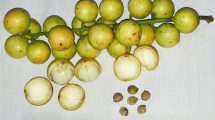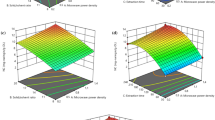Abstract
Nobiletin (NOB) is a well-known polymethoxylated flavone that has only been found in citrus. The objective of this study is to obtain the optimal conditions for extracting nobiletin from sweet orange residues by microwave-assisted extraction (MAE) using response surface method. By using the Box-Behnken experimental design and SAS software 3 independent variables including solid/solvent ratio, microwave power, and treatment time were examined for the response variable nobiletin extraction yield. The regression Eq. 7 statistically significant (p<0.001) and R2 was 0.9189. Based on our regression result and considering the feasibility of experiment conduction, we chose the following independent variable values as the optimized conditions for the extraction of NOB: 1:21.91 (g/mL) for the solid/solvent ratio, 14.16 min for the treatment time, and 693.72 W for the microwave power. Under these conditions, the nobiletin yield of 267.8 μg/g of byproduct was achieved.
Similar content being viewed by others
References
Mouly PP, Gaydou EM, Aazouyan C. Separation and quantitation of orange juices using liquid chromatography of polymethoxylated flavones. Analusis 27: 284–288 (1999)
Dugo P, Mondello L, Dugo G, Heaton DM, Bartle KD, Clifford AA, Myers P. Rapid analysis of polymethoxylated flavones from citrus oils by supercritical fluid chromatography. J. Agr. Food Chem. 44: 3900–3905 (1996)
Delaney B, Phillps K, Vasquez C, Wilson A, Cox D, Wang HB, Manthey J. Genetic toxieity of astandardized mixture of citrus polymethoxylated flavones. Food Chem. Toxicol. 40: 617–624 (2002)
Delaney B, Phillip K, Buswell D, Mowry B, Nickels D, Cox D, Wang HB, Manthey J. Immunotoxicity of a standardized citrus polymethoxylated flavone extract. Food Chem. Toxicol. 11: 1087–1094 (2001)
Manthey JA, Grohmann K. Phenols in citrus peel by products concentrations of hydroxycinnamates and polylmethoxylated flavones in citrus peel molasses. J. Agr. Food Chem. 49: 3268–3273 (2001)
Manach C, Morand C, Gil-Izquierdo A, Bouteloup-Demange C, Remesy C. Bioavailability in humans of the flavanones hesperidin and narirutin after the ingestion of two doses of orange juice. Eur. J. Clin. Nutr. 57: 235–242 (2003)
Nogata Y, Sakamoto K, Shiratsuchi H, Ishii T, Yano M, Ohta H. Flavonoid composition of fruit tissues of citrus species. Biosci. Biotech. Bioch. 70: 178–192 (2006)
Miyata Y, Sato T, Imada K, Dobashi A, Yano M, Ito A. A citrus polymethoxyflavonoid, nobiletin, is a novel MEK inhibitoir that exhibits antitumor metastasis in human fibrosarcoma HT-1080 cells. Biochem. Bioph. Res. Co. 366: 168–173 (2008)
Yi ZB, Yu Y, Liang YZ, Zeng B. In vitro antioxidant and antimicrobial activities of the extract of pericarpium citri reticulatae of a new citrus cultivar and its main flavonoids. LWT-Food Sci. Technol. 41: 597–603 (2008)
Sunagawa Y, Yabuki S, Murakami A, Wada H, Katanasaka Y, Fukuda H, Kimura T, Fujita M, Hasegawa K, Morimoto M. Nobiletin, a citrus flavonoid, prevents the worsening of heart failure in rats with myocardial infarction. J. Card. Fail. 16: S170–S170 (2010)
Lee YC, Cheng TH, Lee JS, Chen JH, Liao YC, Fong Y, Wu CH, Shih YW. Nobiletin, a citrus flavonoid, suppresses invasion and migration involving FAK/PI3K/Akt and small GTPase signals in human gastric adenocarcinoma AGS cells. Mol. Cell. Biochem. 347: 103–115 (2011)
Onozuka H, Nakajima A, Matsuzaki K, Shin RW, Ogino K, Saigusa D, Tetsu N, Yokosuka A, Sashida Y, Mimaki Y, Yamakuni T, Ohizumi Y. Nobiletin, a citrus flavonoid, improves memory impairment and a beta pathology in a transgenic mouse model of Alzheimer’s disease. J. Pharmacol. Exp. Ther. 326: 739–744 (2008)
Wang LC, Weller L. Recent advances in extraction of nutraceuticals from plants. Trends Food Sci. Tech. 17: 300–312 (2006)
Menéndez J, Arenillas A, Fidalgo B, Fernández Y, Zubizarreta L, Calvo EG, Bermúdez JM. Microwave heating processes involving carbon materials. Fuel Process. Technol. 91: 1–8 (2010)
Ohlsson T, Bengtsson N. Microwave technology and foods. Adv. Food Nutr. Res. 43: 65–140 (2001)
Inoue T, Tsubaki S, Ogawa K, Onishi K, Azuma J. Isolation of hesperidin from peels of thinned citrus unshiu fruits by microwaveassisted extraction. Food Chem. 123: 542–547 (2010)
Lucchesi ME, Chemat F, Smadja J. An original solvent free microwave extraction of essential oils from spices. Flavour Frag. J. 19: 134–138 (2004)
He L, Gongke L, Zhanxia Z. Effects of operating parameters on the extraction of resveratrol in huzhang (Polygonum cuspidatum) using microwave-assisted extraction. Chinese J. Anal. Chem. 31: 1341–1344 (2003)
Shu YY, Lai TL, Lin H, Yang TC, Chang CP. Study of factors affecting on the extraction efficiency of polycyclic aromatic hydrocarbons from soils using open-vessel focused microwaveassisted extraction. Chemosphere 52: 1667–1676 (2003)
Bayramoglu B, Sahin S, Sumnu G. Solvent-free microwave extraction of essential oil from oregano. J. Food Eng. 88: 535–540 (2008)
Zhilu A, Juan G, Yuhong W, Yanxia L, Qiuyan Z. Microwaveassisted extraction technique of apple polyphenols in apple pomace. Trans. Chinese Soc. Agr. Eng. 22: 188–191 (2006)
Li MJ, You JY, Liu ZY, Zhang HQ. Microwave-assisted dynamic extraction of flavonoids from flos sophaoae. Chem. Res. Chinese U. 25: 850–852 (2004)
Zhai Y, Sun S, Wang Z, Cheng J, Sun Y, Wang L, Zhang Y, Zhang H, Yu A. Microwave extraction of essential oils from dried fruits of Illicium verum Hook. f. and Cuminum cyminum L. Using ionic liquid as the microwave absorption medium. J. Sep. Sci. 32: 3544–3549 (2009)
Min X, Lu W. Study on extraction of cordycepin with microwave. Food Sci. 27: 248–251 (2006)
Xie JH, Xie MY, Shen MY, Nie SP, Li C, Wang YX. Optimization of microwave-assisted extraction of polysaccharides from Cyclocarya paliurus (Batal.) iljinskaja using response surface methodology. J. Sci. Food Agr. 90: 1353–1360 (2010)
Lee YH, Charles AL, Kung HF, Ho CT, Huang TC. Extraction of nobiletin and tangeretin from Citrus depressa Hayata by supercritical carbon dioxide with ethanol as modifier. Ind. Crop Prod. 31: 59–64 (2010)
Hemwimol S, Pavasant P, Shotipruk A. Ultrasound-assisted extraction of anthraquinones from roots of Morinda citrifolia. Ultrason. Sonochem. 13: 543–548 (2006)
Eskilsson CS, Bjorklund E. Analytical-scale microwave-assisted extraction. J. Chromatogr. A 902: 227–250 (2000)
Baş D, Boyacı İH. Modeling and optimization I: Usability of response surface methodology. J. Food Eng. 78: 836–845 (2007)
Zhao W, Yu Z, Liu J, Yu Y, Yin Y, Lin S, Chen F. Optimized extraction of polysaccharides from corn silk by pulsed electric field and response surface quadratic design. J. Sci. Food Agr. 91: 2201–2209 (2011)
Author information
Authors and Affiliations
Corresponding author
Rights and permissions
About this article
Cite this article
Zhang, Y., Li, H., Dou, H. et al. Optimization of nobiletin extraction assisted by microwave from orange byproduct using response surface methodology. Food Sci Biotechnol 22 (Suppl 1), 153–159 (2013). https://doi.org/10.1007/s10068-013-0061-5
Received:
Revised:
Accepted:
Published:
Issue Date:
DOI: https://doi.org/10.1007/s10068-013-0061-5




